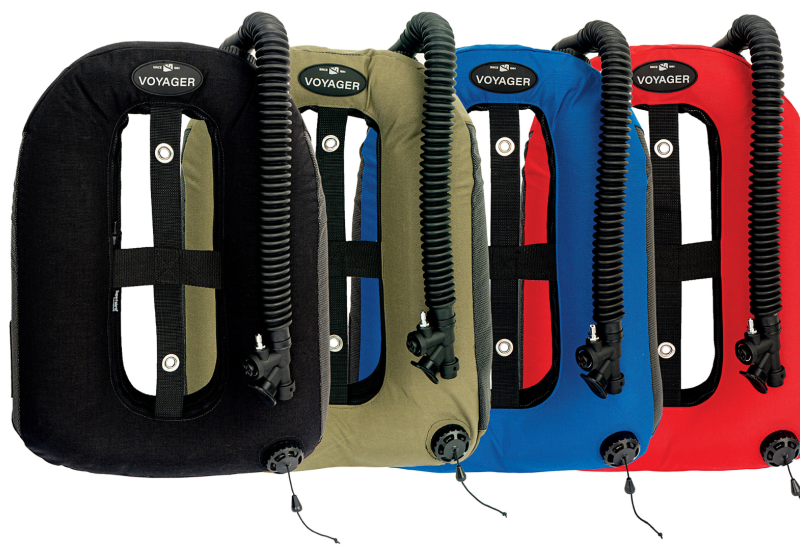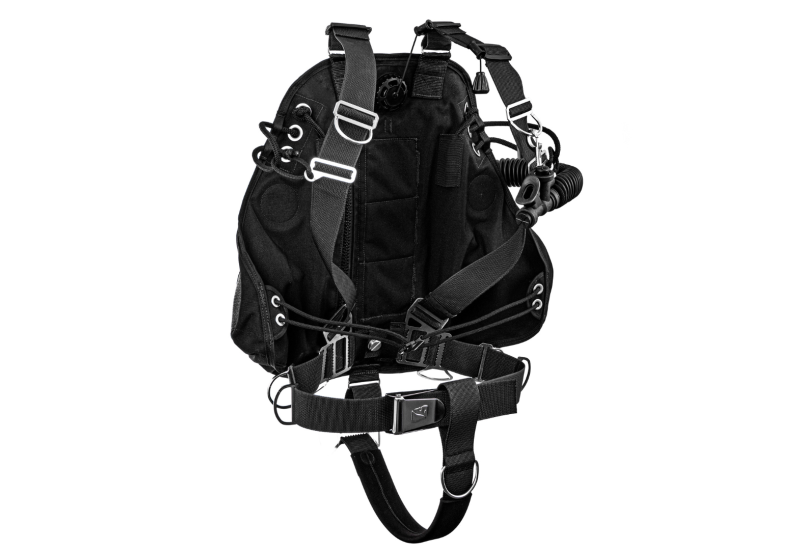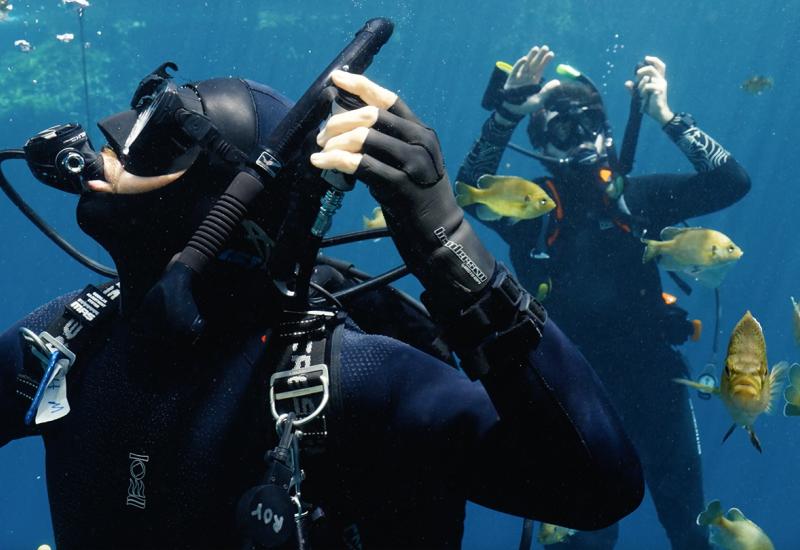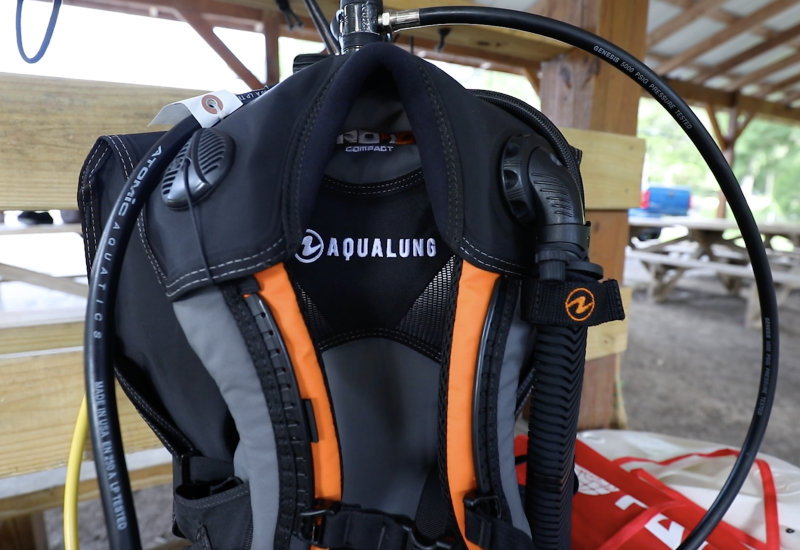The Best Weight-Integrated BCs

March 2004
By John Brumm
Photography by Mitch Mandel
||
|---|
|

|
| A tester hits the water.|
These days, we've got TVs in our SUVs and cameras in our cell phones, so why not ballast in our BCs?
Look around any dive resort you visit, or any dive boat you board, and you'll find more and more divers using BCs with integrated weight systems. The 11 models reviewed here--seven back-buoyancy, two jacket-style and two hybrid designs--represent the latest thinking in the best way to combine your weight belt with your BC.
The Test Regimen
In addition to all the usual functions of a typical BC, weight-integrated models have to securely hold and--on demand--easily ditch the weight they carry. To accomplish this, manufacturers offer an array of ballast pouch designs with a variety of mechanical and Velcro release systems. And as we found in our tests, some clearly work better than others.
To test these BCs, we started with objective evaluations conducted by Scuba Lab staff in a dive training pool. We deflated each of the BCs and measured them for inherent buoyancy (ideally, your BC should have little to no inherent buoyancy), then inflated and measured them for buoyant lift to see how much variance there was from the manufacturer's claims. Then we tested the flow rates of the inflate and deflate valves. Our goal: To see if the deflation rate exceeds the inflation rate. The reason: If the inflation valve sticks open, you can still control your ascent if you can dump air faster than it's being added.
||
|---|
|

|
| Gear check.|
Then came the ergonomic tests, performed in a real-world ocean environment by a team of experienced divers--two-thirds male, one-third female, ranging in age from their mid-20s to late 50s. We loaded the BCs and our test team onto the dive boat Island Time and transported them to Catalina Island, where we spent four days in the water focusing on a range of BC functions, from the highly critical ascent control and stability at depth, to valve operation, the ease and efficiency of the weight ditch system and, of course, comfort. Also noted were a number of convenience elements including the ease of assembly and the use and accessibility of pockets and attachments. You'll find these scores in the ergonomics chart.
When all tests were completed, we crunched the data and found four models at the top of the pack, followed closely by a number of very good performers.
Defining Our Terms
When you see the word excellent, very good, good, fair or poor in bold, it represents a numeric score on a five-point scale that encapsulates the results of our tests.
(5-Excellent; 4-Very Good; 3-Good; 2-Fair; 1-Poor).
 |
| Scuba Lab director John Brumm briefing the test team. |
The Testers' Choices
The cream of the crop. These four BCs earned more performance points than their competitors, with the Oceanic Probe QLR, Aeris Atmos XT and Mares V1 MRS delivering the best combined scores in ascent control, stability and valve operation, while the DeepOutdoors Matrix Standard led the pack in comfort and with its weight ditch system. All boast little to no inherent buoyancy, and two earned perfect scores for their flow rates.
||
|---|
|

|
| OCEANIC Probe QLR|
OCEANIC Probe QLR
This redesigned jacket-style BC from Oceanic earns the top spot in this year's test. The new Probe provides more buoyant lift than its predecessor, and is now equipped with Oceanic's Quick Lock Release mechanical weight ditch system. Also new: The BC's two large primary pockets now have zippers, plus a couple of accessory pockets have been added.
In our objective tests, the Probe QLR registered zero inherent buoyancy (one of only three models in this test to do so), and scored three out of a possible three on the flow rate tests. In the ergonomic tests, our divers said this BC "fits like a glove," and it earned very good marks for stability, both under water and while floating on the surface. They also scored it very good for ascent control and praised the low-profile power inflator that allows you to inflate and deflate without changing hand position.
Constructed of 1,600-denier nylon, the Probe QLR provides velour-covered padding on the back and lumbar region and additional velour around the waist to improve comfort. The molded plastic carry handle simplifies handling, although the BC doesn't have a tank positioning strap. Built-in attachment points allow you to install an optional knife or retractor, and for tech-oriented divers, the Probe QLR can be adapted to handle double tanks.
||
|---|
|

|
| AERIS Atmos XT|
AERIS Atmos XT
A hybrid design, the Atmos XT combines back buoyancy with an air cell that wraps under the arms. According to Aeris, the design provides better body orientation under water and an effortless upright surface position when fully inflated. According to our test divers, Aeris got it right. They rated the Atmos XT very good for stability at depth, and said the BC offers a comfortable surface floating position.
This model has a streamlined feel to it--there's no sense of clutter in the chest area. A soft pad cushions the back and lumbar regions, and there's a nice molded plastic handle for hefting the BC from car trunk to boat deck. The Atmos we tested came with a detachable pocket you can position on either the left or right side of the cummerbund. Or you can use the attachment hardware to mount an optional knife.
The Atmos XT's integrated weight system uses mechanical security clips backed by Velcro. The vertically positioned weight pouches load and ditch efficiently. In the water, the BC has negligible inherent buoyancy (just over a pound), and it earned a best-possible score of three out of three for its airflow system. Test divers scored the Atmos XT very good for both ascent control and valve operation; they loved the efficiency of the right shoulder exhaust valve, as well as the user-friendliness of the power inflator. At a suggested retail price of $469.95, it's also a Best Buy.

||
|---|
|

|
| MARES V1 MRS|
MARES V1 MRS
The Mares V1 is a classic jacket-style BC that uses Mares' unique MRS integrated weight system. In previous tests of Mares BCs, Scuba Lab found the MRS system sloppy, hard to load and difficult to ditch. However, on the streamlined V1, the MRS is much more efficient. The plastic plugs on the removable weight pouches find their way into the plastic tracks in the BC pouch sleeves without any coaxing. Having less play in the pouch sleeves also makes ditching the weights much easier than in the past. Because the streamlined BC sleeves don't bag out, you can easily depress the release buttons on the plastic handles, pull out on the handles and slide the weight pouches from the sleeves in one fluid motion.
Test divers found the V1 to be a comfortable, snug-fitting BC with nice padding on the back and lumbar area and a soft carry handle that can double as a tank positioning strap. They rated it very good on pocket placement and accessibility, although the pockets would benefit from a bottom pleat to increase volume. Test divers also rated the V1 very good for stability, both at depth and on the surface, and found the power inflator to be very comfortable in the hand, with easy access to control buttons.
In the objective flow rate tests, two out of three deflate methods available in a heads-up position were able to keep ahead of the inflator, and the V1 registered less than a pound of inherent buoyancy. With a suggested retail price of $479, it's also a Best Buy in this test group.
||
|---|
|

|
| DEEPOUTDOORS Matrix Standard|
DEEPOUTDOORS Matrix Standard
The Matrix back-buoyancy BC we tested was the Standard, which is more suited to recreational diving than the Custom version, but it's still pretty "techy." The Standard uses double waist straps with a big stainless steel buckle and sports lots of stainless steel D-rings. There's a thick lumbar pad for comfort, contoured shoulders, a trapezoidal strap system and removable crotch strap for fit, and huge ditchable weight pouches that will hold up to 40 pounds of ballast. The Matrix is twin-tank adaptable and can be equipped with optional stainless steel backplate, stowage pockets and trim pouches.
A unique feature of this BC is a cordura sleeve that keeps the low-pressure inflator hose joined to the corrugated hose. The power inflator pumps a lot of air fast, but its old-style design feels clunky in the hand--test divers were unanimous in this opinion. And while test divers said holding the corrugated hose overhead vented air fast enough to control ascent, they found the pull dump to be extremely slow during the ergo tests. This was borne out by the objective flow rate tests.
However, test divers rated the Matrix one of the most comfortable BCs in this test go-round, and one of the most stable at depth. The Matrix was one of only two BCs to earn an excellent score for weight ditching, and one of only a handful of BCs rated very good for the ease of loading weights. Both scores reflect the ample size of the weight pouch sleeves as well as the pouches themselves. Also, the pouch handles are easy to grasp, and the triple-flap Velcro system holds weights secure but isn't too grabby when it comes time to ditch.
Very Good Performers
While they didn't collect quite enough points to earn Testers' Choice designations, these four BCs are nevertheless top performers. With one exception, performance in the critical ergonomic areas of ascent control and stability ranges from good to very good, and, again with one exception, performance in important areas like valve operation and weight ditching ranges from good to excellent.
||
|---|
|

|
| TUSA Imprex Pro Cubic|
TUSA Imprex Pro Cubic
Designed for the more advanced diver, the Imprex Pro Cubic is a back-buoyancy BC sporting a high-lift bladder. Tusa's Independent Harness and Waist Support systems provide lots of adjustment for varying body shapes. The BC has a 1,000 denier shell, contoured shoulder straps and a backpack with rigid nonskid runners to support the tank. The weight ditch system secures with Velcro flaps. For storage, there's a large mesh bag that deploys easily and can be unclipped from the BC.
In the water, the Imprex Pro Cubic earned very good scores from test divers for stability. They also found the BC provides a comfortable surface floating position when partially inflated. Awarding another very good rating for valve operation, test divers found the power inflator to be very user-friendly, with remote valves easy to access and activate. This BC scored three out of a possible three in the valve flow tests, and registered just over two pounds of inherent buoyancy.
||
|---|
|

|
| SEAQUEST Fusion|
SEAQUEST Fusion
The Fusion's hybrid design positions buoyancy between the tank and diver and under the arms. It's a winning combination--the Fusion scored very good for stability both at depth and on the surface. It also rated very good for comfort thanks to its shoulder swivel buckles, trapezoid strap system and abundant padding.
With a power inflator that attaches just below the left weight pouch, the Fusion eliminates the traditional corrugated hose. You deflate the BC from two lower rear exhaust valves or a right shoulder valve. On a standard heads-up ascent, this system may require two hands--the left to operate the inflate button, and the right to operate the shoulder exhaust valve. Test divers gave it only a fair score for ascent control.
The Fusion's Sure Lock mechanical weight release system, however, earned an excellent score for ditching and a very good for loading, thanks to weight pouches that snap securely into place but ditch with just a tug.
||
|---|
|

|
| SHERWOOD SCUBA Outback|
SHERWOOD SCUBA Outback
The Outback is a rugged back-buoyancy BC designed for advanced or technical divers. It has a heavy-duty harness with no padding to speak of, and one-time screw-down adjustments on the cummerbund and shoulders to customize fit. It has lots of stainless steel D-rings and can be rigged for twin tanks. In its standard form, it is fitted with the Mini-Pac, a semi-hard backpack that offers both stability and comfort. There's an adjustable sternum strap for a dry suit chest valve.
The BC uses Sherwood's CQR mechanical weight ditch system. Test divers rated it very good for weight ditching, but said the loading phase was only fair, due to the difficulty in clipping the security buckles while wearing the BC. The solution is either to load the BC prior to donning or get a buddy's help. The Outback has just one pound of inherent buoyancy, and its two shoulder-mounted deflate methods easily keep pace with inflation.
||
|---|
|

|
| DACOR Falcon|
DACOR Falcon
Simplicity is key with Dacor's lightweight, back-buoyancy Falcon. The BC uses a waist buckle instead of a cummerbund and has a rigid but comfortable backpack. The harness has swivel shoulder buckles to improve strap routing, a neoprene collar and under-shoulder padding.
The Pocket Lock weight system, using squeeze buckles backed by Velcro, got mixed reviews. Although the system earned very good scores for easy loading, the spacious pouches caused ballast to shift. And while weights can technically be ditched in a one-step motion (ignore the handles, squeeze the buckles, grab the female portions and yank), real-world use mandates two steps (one to unclip the buckles and another to pull the handles), which resulted in only fair scores for ditching. Test divers did like the streamlined power inflator, which contributed to very good scores for valve operation. The Falcon registers less than a pound of inherent buoyancy and sports an efficient pull dump.
Good Performers
These are solid, no-nonsense BCs that offer respectable across-the-board performance. While sharing the dubious distinction of having under-performing pull dump valves--which contributed to fair ascent control ratings in two of the three--in most other tests these BCs delivered good to very good performance.
||
|---|
|

|
| DUI Delta Wings|
DUI Delta Wings
With a high-lift bladder, high-load weight system, heavy-duty D-rings and snappy retractor system, the Delta Wings may be better-suited to tech divers than rec divers. This one-size-fits-all BC successfully incorporates straps and one-time adjustments to allow virtually any diver to find the perfect fit. The model we tested was able to accommodate all test divers, from 6'2", 190-pound males to 5'2", 105-pound females, who as a group rated it very good for assembly as well as for fit and comfort.
However, test divers found ascent control to be a challenge, rating it only fair due primarily to a bulky old-style power inflator and an inefficient pull dump. While awkward in the hand, the power inflator does pump air forcefully, and the deflator button vents air efficiently when held overhead.
The Delta Wings registers no inherent buoyancy, and the weight system's huge pouches load and ditch weight easily. However, the BC has no trim pouches or storage pockets.
||
|---|
|

|
| INTERNATIONAL DIVERS Advantage|
INTERNATIONAL DIVERS Advantage
The redesigned back-buoyancy Advantage comes in three models: a heavy-duty version for technical divers, a standard version for recreational divers and a stripped-down version for travel divers. We tested the standard version, which is a much simpler design than the original Advantage with zero inherent buoyancy, fewer straps, a more user-friendly harness, improved ergonomics on its power inflator and a much better weight system.
While easier to assemble and adjust than the original, the new Advantage earned only fair scores for comfort. Test divers found the weight pouch/cummerbund system bulky and cumbersome and out of proportion with the BC's other adjustments. Also, the stiff web overstrap on the waist was difficult to adjust. Finally, the top tank strap was positioned so high on the backpack that test divers found it difficult to position the BC on the tank so that the tank yoke and regulator first stage wouldn't hit the back of their heads.
||
|---|
|

|
| OCEAN MASTER Knight Pro|
OCEAN MASTER Knight Pro
The back-buoyancy Knight Pro has a unique gel-filled pad to cushion the back and lumbar region, and the gel-padded under-shoulders are textured to reduce slippage. Combined with an efficient strap system, the BC provides a comfortable, supportive fit at depth. The BC could use a handle as well as a tank positioning strap.
The power inflator comes with an emergency horn as standard equipment. The horn is effective, but it tends to clutter up the inflator housing, making it too bulky for small hands and too busy for others, contributing to a fair score for valve operation. This, combined with an inefficient pull dump valve, also made it more difficult for test divers to maintain ascent control, resulting in an additional fair rating in that critical category.
However, test divers rated the one-step mechanical integrated weight system as good for weight loading and very good for weight ditching. The Knight Pro has five pounds of inherent buoyancy, the highest in this test group.
For More Info
AERIS
www.diveaeris.com
DACOR
www.divedacor.com
DEEPOUTDOORS
www.deepoutdoors.com
DIVERS UNLIMITED INTL.
www.dui-online.com
INTERNATIONAL DIVERS
www.internationaldivers.com
MARES
www.mares.com
OCEAN MASTER
www.oceanmaster.com
OCEANIC
www.oceanww.com
SEAQUEST
www.sea-quest.com
SHERWOOD SCUBA
www.sherwoodscuba.com
TUSA
www.tusa.com
Looking for Scubapro?
Scubapro has declined to provide its products for Scuba Lab tests, including this weight-integrated BCs review.
Weight Ditching Q & A
Q: Which is better: Velcro or mechanical systems?
A: When last we looked at weight-integrated BCs as a category, more than 70 percent of the BCs reviewed used Velcro security systems to prevent their weight pouches from ditching accidentally. This year, over 80 percent of BCs reviewed use mechanical security systems (although some of these use a bit of Velcro as back-up). This trend suggests that the majority of manufacturers have come to prefer the decisive click of a mechanical buckle when it comes to securing weight systems. However, don't discount Velcro systems: of the two BCs earning excellent scores for their integrated weight systems, the SeaQuest Fusion is mechanical, and the DeepOutdoors Matrix is, you guessed it, Velcro.
Q: Which is better: Hard or soft weights?
A: Although a number of BC owners' manuals recommend using soft weights in their weight pouches, it turns out soft weights can be a problem for some BC systems. Soft weights tend to work well in streamlined, contoured pouches that force soft weights to mold to--and then maintain--the shape of the pouch. But pouches that are too roomy, or that don't form fit against a diver's body, can allow soft weights to bunch up and settle in the bottom of the pouch like a lead blob, which can cause problems when it comes time to ditch. Granted, hard weights aren't as comfortable as soft weights, but they are often easier to load into pouches. They also allow the weight pouches to load easier into BC sleeves, and, because they tend to present a thinner profile in the pouch, they ditch more easily.
Q: Should I load weights before or after I put the BC on?
A: Loading before you put on the BC can be easier, but then you have to lift a lot more weight onto your back. Of course, depending on what BC you're wearing, loading weights after you put on your BC can range from easy-as-pie to downright difficult. Which way is best? It depends on who you ask. Either way, it doesn't hurt to get a little help from friends. If you load beforehand, your buddy can help you with the hefting. If you load afterward, your buddy can help you stuff pouches and make sure they're properly secured. Whether you load your BC before or after, fully deflate the bladder before inserting the pouches. And if you load while wearing the BC, pouches will often load into sleeves more easily if the cummerbund is unhooked.
Defining Flow Rates
This is how we now test for flow rates. In a heads-up ascent position, with the BC totally empty, at a depth of approximately 14 feet, the inflation valve is simultaneously activated for 20 seconds along with an applicable deflate valve (those located in the shoulder areas, or the highest valve on the BC while in a heads-up ascent position) to determine whether deflation can stay ahead of inflation. After 20 seconds, we note the results, and then immediately move to the next applicable valve and repeat the process.
BCs are scored for whether or not each exhaust valve can stay ahead of the power inflator. It's as simple as that. However, the number of exhaust valves that can stay ahead of the power inflator while in an ascent position is also noted. The way we see it, the more the better.
A Word About Buoyant Lift
Some weight-integrated BCs tested here are capable of being loaded with weight exceeding their total buoyant lift, especially in the smaller sizes. If you're a warm-water diver who wears minimal exposure protection and therefore needs little ballast weight, this is of little concern. However, if you dive with a thick wetsuit or dry suit with substantial ballast requirements, then you'd better make sure your BC has enough lift.
Past Scuba Lab tests have determined that a BC should provide enough buoyant lift to allow you to achieve neutral buoyancy at no more than 50 percent of its full inflation, under the most demanding conditions, i.e., maximum depth with maximum suit compression. This way you have a buoyancy reserve in case of emergencies.
For this reason, we also test manufacturer claims of buoyant lift. In this group of BCs, we once again found that the buoyant lift of some models varies considerably from what's stated in the owner's manual.
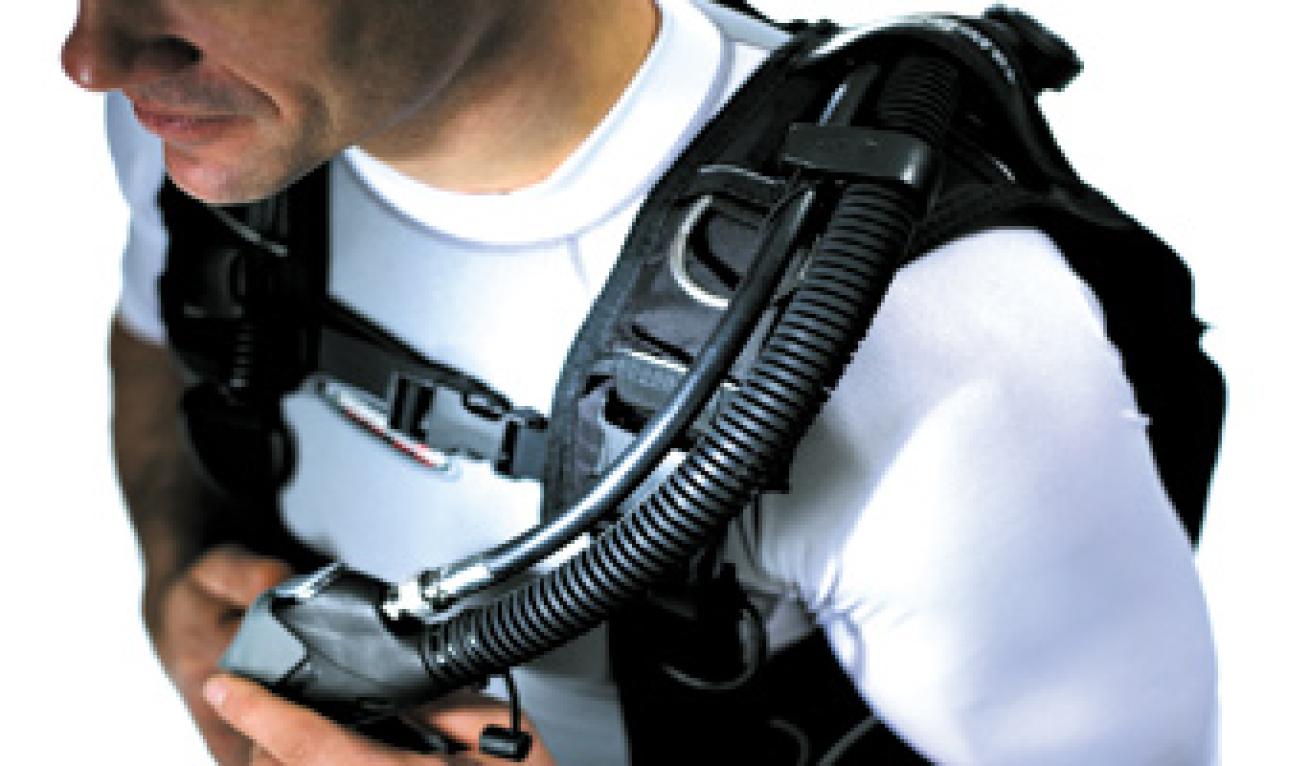
March 2004
By John Brumm
Photography by Mitch Mandel

| | A tester hits the water.| These days, we've got TVs in our SUVs and cameras in our cell phones, so why not ballast in our BCs?
Look around any dive resort you visit, or any dive boat you board, and you'll find more and more divers using BCs with integrated weight systems. The 11 models reviewed here--seven back-buoyancy, two jacket-style and two hybrid designs--represent the latest thinking in the best way to combine your weight belt with your BC.
The Test Regimen
In addition to all the usual functions of a typical BC, weight-integrated models have to securely hold and--on demand--easily ditch the weight they carry. To accomplish this, manufacturers offer an array of ballast pouch designs with a variety of mechanical and Velcro release systems. And as we found in our tests, some clearly work better than others.
To test these BCs, we started with objective evaluations conducted by Scuba Lab staff in a dive training pool. We deflated each of the BCs and measured them for inherent buoyancy (ideally, your BC should have little to no inherent buoyancy), then inflated and measured them for buoyant lift to see how much variance there was from the manufacturer's claims. Then we tested the flow rates of the inflate and deflate valves. Our goal: To see if the deflation rate exceeds the inflation rate. The reason: If the inflation valve sticks open, you can still control your ascent if you can dump air faster than it's being added.
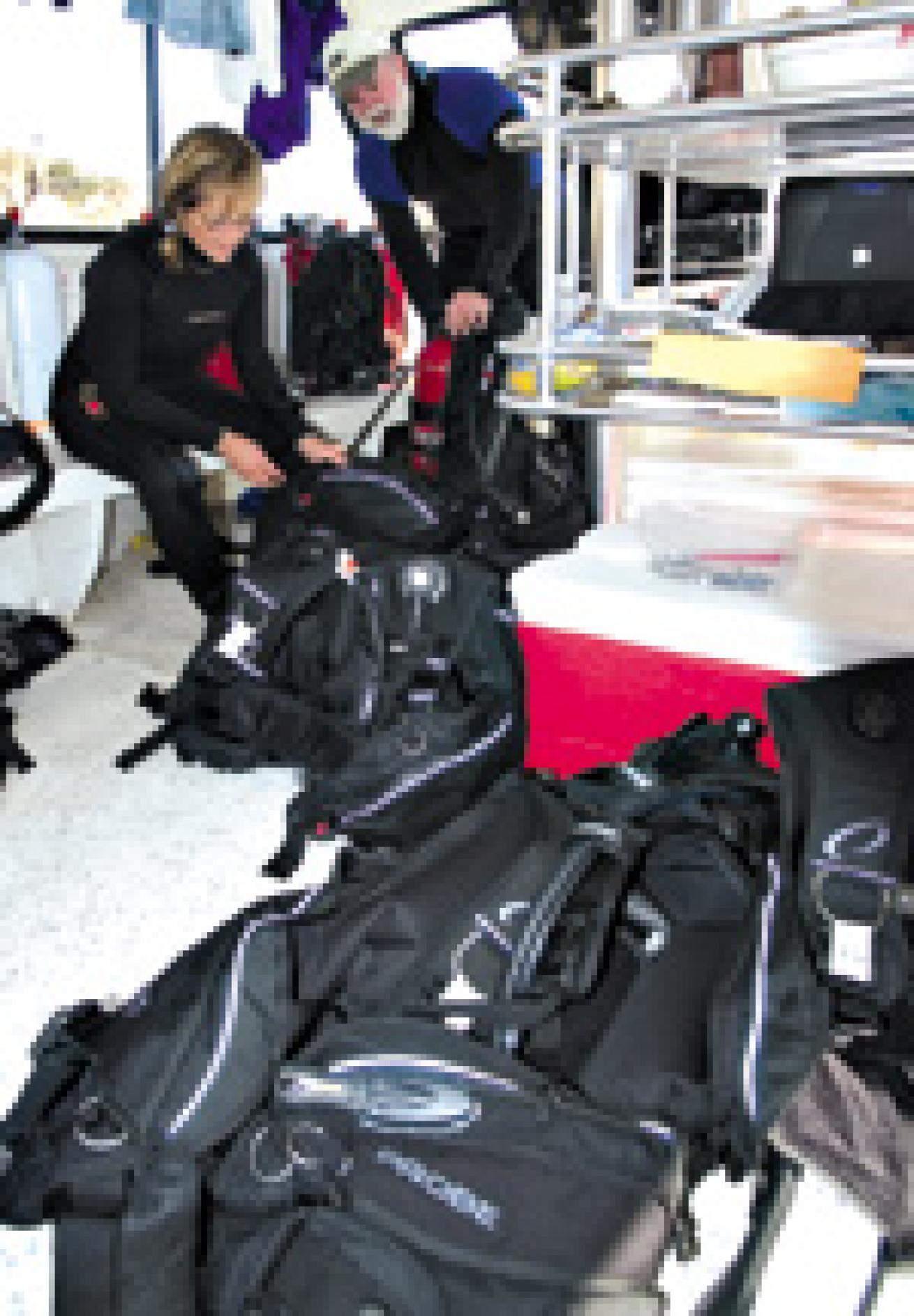
| | Gear check.| Then came the ergonomic tests, performed in a real-world ocean environment by a team of experienced divers--two-thirds male, one-third female, ranging in age from their mid-20s to late 50s. We loaded the BCs and our test team onto the dive boat Island Time and transported them to Catalina Island, where we spent four days in the water focusing on a range of BC functions, from the highly critical ascent control and stability at depth, to valve operation, the ease and efficiency of the weight ditch system and, of course, comfort. Also noted were a number of convenience elements including the ease of assembly and the use and accessibility of pockets and attachments. You'll find these scores in the ergonomics chart.
When all tests were completed, we crunched the data and found four models at the top of the pack, followed closely by a number of very good performers.
Defining Our Terms
When you see the word excellent, very good, good, fair or poor in bold, it represents a numeric score on a five-point scale that encapsulates the results of our tests.
(5-Excellent; 4-Very Good; 3-Good; 2-Fair; 1-Poor).
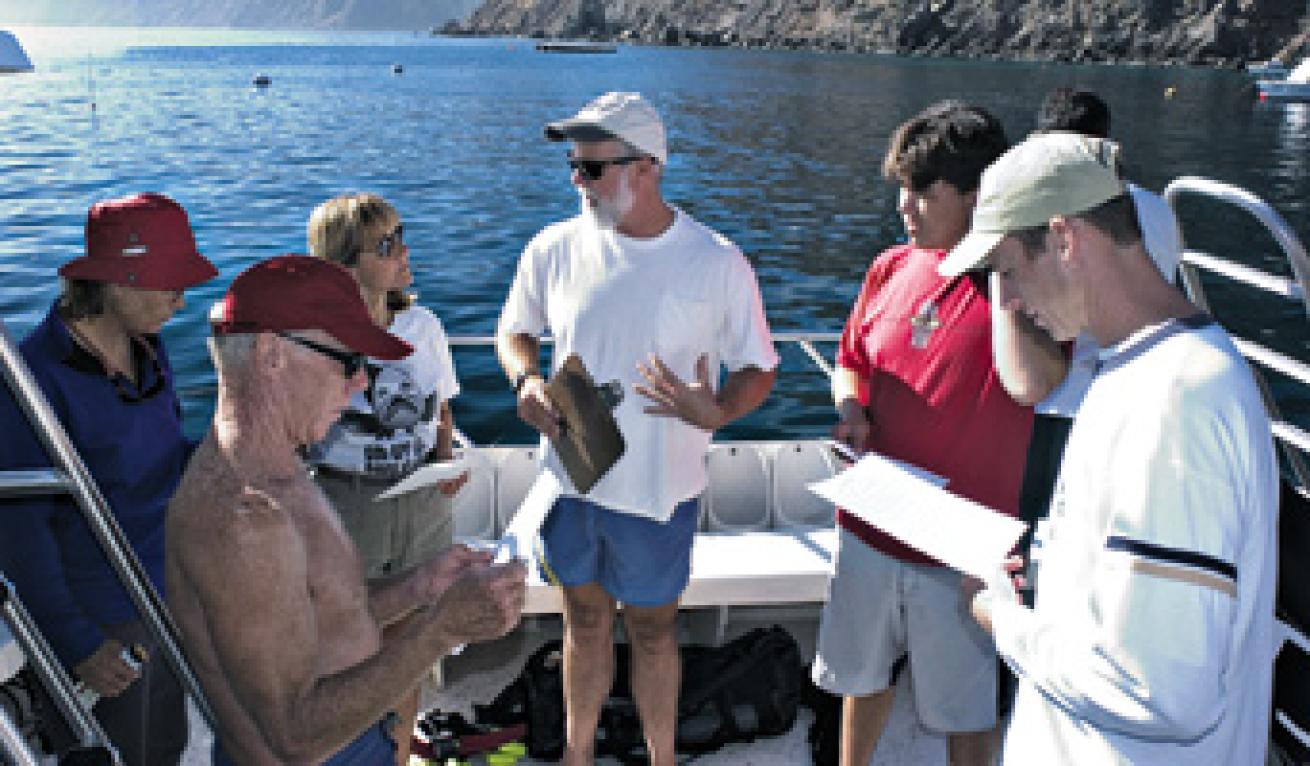
| | Scuba Lab director John Brumm briefing the test team.|
The Testers' Choices
The cream of the crop. These four BCs earned more performance points than their competitors, with the Oceanic Probe QLR, Aeris Atmos XT and Mares V1 MRS delivering the best combined scores in ascent control, stability and valve operation, while the DeepOutdoors Matrix Standard led the pack in comfort and with its weight ditch system. All boast little to no inherent buoyancy, and two earned perfect scores for their flow rates.

| | OCEANIC Probe QLR| OCEANIC Probe QLR
This redesigned jacket-style BC from Oceanic earns the top spot in this year's test. The new Probe provides more buoyant lift than its predecessor, and is now equipped with Oceanic's Quick Lock Release mechanical weight ditch system. Also new: The BC's two large primary pockets now have zippers, plus a couple of accessory pockets have been added.
In our objective tests, the Probe QLR registered zero inherent buoyancy (one of only three models in this test to do so), and scored three out of a possible three on the flow rate tests. In the ergonomic tests, our divers said this BC "fits like a glove," and it earned very good marks for stability, both under water and while floating on the surface. They also scored it very good for ascent control and praised the low-profile power inflator that allows you to inflate and deflate without changing hand position.
Constructed of 1,600-denier nylon, the Probe QLR provides velour-covered padding on the back and lumbar region and additional velour around the waist to improve comfort. The molded plastic carry handle simplifies handling, although the BC doesn't have a tank positioning strap. Built-in attachment points allow you to install an optional knife or retractor, and for tech-oriented divers, the Probe QLR can be adapted to handle double tanks.

| | AERIS Atmos XT| AERIS Atmos XT
A hybrid design, the Atmos XT combines back buoyancy with an air cell that wraps under the arms. According to Aeris, the design provides better body orientation under water and an effortless upright surface position when fully inflated. According to our test divers, Aeris got it right. They rated the Atmos XT very good for stability at depth, and said the BC offers a comfortable surface floating position.
This model has a streamlined feel to it--there's no sense of clutter in the chest area. A soft pad cushions the back and lumbar regions, and there's a nice molded plastic handle for hefting the BC from car trunk to boat deck. The Atmos we tested came with a detachable pocket you can position on either the left or right side of the cummerbund. Or you can use the attachment hardware to mount an optional knife.
The Atmos XT's integrated weight system uses mechanical security clips backed by Velcro. The vertically positioned weight pouches load and ditch efficiently. In the water, the BC has negligible inherent buoyancy (just over a pound), and it earned a best-possible score of three out of three for its airflow system. Test divers scored the Atmos XT very good for both ascent control and valve operation; they loved the efficiency of the right shoulder exhaust valve, as well as the user-friendliness of the power inflator. At a suggested retail price of $469.95, it's also a Best Buy.


| | MARES V1 MRS| MARES V1 MRS
The Mares V1 is a classic jacket-style BC that uses Mares' unique MRS integrated weight system. In previous tests of Mares BCs, Scuba Lab found the MRS system sloppy, hard to load and difficult to ditch. However, on the streamlined V1, the MRS is much more efficient. The plastic plugs on the removable weight pouches find their way into the plastic tracks in the BC pouch sleeves without any coaxing. Having less play in the pouch sleeves also makes ditching the weights much easier than in the past. Because the streamlined BC sleeves don't bag out, you can easily depress the release buttons on the plastic handles, pull out on the handles and slide the weight pouches from the sleeves in one fluid motion.
Test divers found the V1 to be a comfortable, snug-fitting BC with nice padding on the back and lumbar area and a soft carry handle that can double as a tank positioning strap. They rated it very good on pocket placement and accessibility, although the pockets would benefit from a bottom pleat to increase volume. Test divers also rated the V1 very good for stability, both at depth and on the surface, and found the power inflator to be very comfortable in the hand, with easy access to control buttons.
In the objective flow rate tests, two out of three deflate methods available in a heads-up position were able to keep ahead of the inflator, and the V1 registered less than a pound of inherent buoyancy. With a suggested retail price of $479, it's also a Best Buy in this test group.

| | DEEPOUTDOORS Matrix Standard| DEEPOUTDOORS Matrix Standard
The Matrix back-buoyancy BC we tested was the Standard, which is more suited to recreational diving than the Custom version, but it's still pretty "techy." The Standard uses double waist straps with a big stainless steel buckle and sports lots of stainless steel D-rings. There's a thick lumbar pad for comfort, contoured shoulders, a trapezoidal strap system and removable crotch strap for fit, and huge ditchable weight pouches that will hold up to 40 pounds of ballast. The Matrix is twin-tank adaptable and can be equipped with optional stainless steel backplate, stowage pockets and trim pouches.
A unique feature of this BC is a cordura sleeve that keeps the low-pressure inflator hose joined to the corrugated hose. The power inflator pumps a lot of air fast, but its old-style design feels clunky in the hand--test divers were unanimous in this opinion. And while test divers said holding the corrugated hose overhead vented air fast enough to control ascent, they found the pull dump to be extremely slow during the ergo tests. This was borne out by the objective flow rate tests.
However, test divers rated the Matrix one of the most comfortable BCs in this test go-round, and one of the most stable at depth. The Matrix was one of only two BCs to earn an excellent score for weight ditching, and one of only a handful of BCs rated very good for the ease of loading weights. Both scores reflect the ample size of the weight pouch sleeves as well as the pouches themselves. Also, the pouch handles are easy to grasp, and the triple-flap Velcro system holds weights secure but isn't too grabby when it comes time to ditch.
Very Good Performers
While they didn't collect quite enough points to earn Testers' Choice designations, these four BCs are nevertheless top performers. With one exception, performance in the critical ergonomic areas of ascent control and stability ranges from good to very good, and, again with one exception, performance in important areas like valve operation and weight ditching ranges from good to excellent.

| | TUSA Imprex Pro Cubic| TUSA Imprex Pro Cubic
Designed for the more advanced diver, the Imprex Pro Cubic is a back-buoyancy BC sporting a high-lift bladder. Tusa's Independent Harness and Waist Support systems provide lots of adjustment for varying body shapes. The BC has a 1,000 denier shell, contoured shoulder straps and a backpack with rigid nonskid runners to support the tank. The weight ditch system secures with Velcro flaps. For storage, there's a large mesh bag that deploys easily and can be unclipped from the BC.
In the water, the Imprex Pro Cubic earned very good scores from test divers for stability. They also found the BC provides a comfortable surface floating position when partially inflated. Awarding another very good rating for valve operation, test divers found the power inflator to be very user-friendly, with remote valves easy to access and activate. This BC scored three out of a possible three in the valve flow tests, and registered just over two pounds of inherent buoyancy.

| | SEAQUEST Fusion| SEAQUEST Fusion
The Fusion's hybrid design positions buoyancy between the tank and diver and under the arms. It's a winning combination--the Fusion scored very good for stability both at depth and on the surface. It also rated very good for comfort thanks to its shoulder swivel buckles, trapezoid strap system and abundant padding.
With a power inflator that attaches just below the left weight pouch, the Fusion eliminates the traditional corrugated hose. You deflate the BC from two lower rear exhaust valves or a right shoulder valve. On a standard heads-up ascent, this system may require two hands--the left to operate the inflate button, and the right to operate the shoulder exhaust valve. Test divers gave it only a fair score for ascent control.
The Fusion's Sure Lock mechanical weight release system, however, earned an excellent score for ditching and a very good for loading, thanks to weight pouches that snap securely into place but ditch with just a tug.
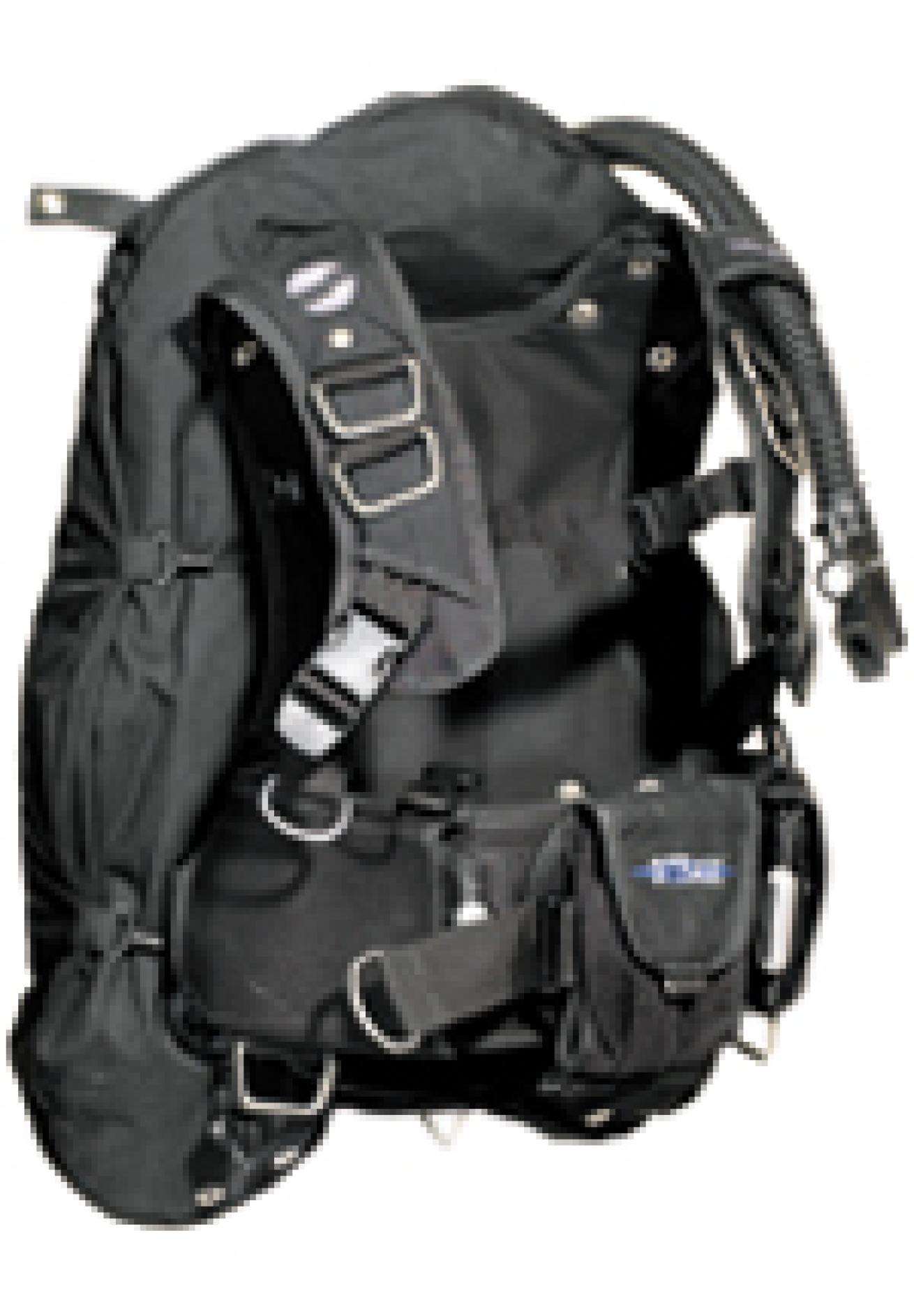
| | SHERWOOD SCUBA Outback| SHERWOOD SCUBA Outback
The Outback is a rugged back-buoyancy BC designed for advanced or technical divers. It has a heavy-duty harness with no padding to speak of, and one-time screw-down adjustments on the cummerbund and shoulders to customize fit. It has lots of stainless steel D-rings and can be rigged for twin tanks. In its standard form, it is fitted with the Mini-Pac, a semi-hard backpack that offers both stability and comfort. There's an adjustable sternum strap for a dry suit chest valve.
The BC uses Sherwood's CQR mechanical weight ditch system. Test divers rated it very good for weight ditching, but said the loading phase was only fair, due to the difficulty in clipping the security buckles while wearing the BC. The solution is either to load the BC prior to donning or get a buddy's help. The Outback has just one pound of inherent buoyancy, and its two shoulder-mounted deflate methods easily keep pace with inflation.

| | DACOR Falcon| DACOR Falcon
Simplicity is key with Dacor's lightweight, back-buoyancy Falcon. The BC uses a waist buckle instead of a cummerbund and has a rigid but comfortable backpack. The harness has swivel shoulder buckles to improve strap routing, a neoprene collar and under-shoulder padding.
The Pocket Lock weight system, using squeeze buckles backed by Velcro, got mixed reviews. Although the system earned very good scores for easy loading, the spacious pouches caused ballast to shift. And while weights can technically be ditched in a one-step motion (ignore the handles, squeeze the buckles, grab the female portions and yank), real-world use mandates two steps (one to unclip the buckles and another to pull the handles), which resulted in only fair scores for ditching. Test divers did like the streamlined power inflator, which contributed to very good scores for valve operation. The Falcon registers less than a pound of inherent buoyancy and sports an efficient pull dump.
Good Performers
These are solid, no-nonsense BCs that offer respectable across-the-board performance. While sharing the dubious distinction of having under-performing pull dump valves--which contributed to fair ascent control ratings in two of the three--in most other tests these BCs delivered good to very good performance.

| | DUI Delta Wings| DUI Delta Wings
With a high-lift bladder, high-load weight system, heavy-duty D-rings and snappy retractor system, the Delta Wings may be better-suited to tech divers than rec divers. This one-size-fits-all BC successfully incorporates straps and one-time adjustments to allow virtually any diver to find the perfect fit. The model we tested was able to accommodate all test divers, from 6'2", 190-pound males to 5'2", 105-pound females, who as a group rated it very good for assembly as well as for fit and comfort.
However, test divers found ascent control to be a challenge, rating it only fair due primarily to a bulky old-style power inflator and an inefficient pull dump. While awkward in the hand, the power inflator does pump air forcefully, and the deflator button vents air efficiently when held overhead.
The Delta Wings registers no inherent buoyancy, and the weight system's huge pouches load and ditch weight easily. However, the BC has no trim pouches or storage pockets.

| | INTERNATIONAL DIVERS Advantage| INTERNATIONAL DIVERS Advantage
The redesigned back-buoyancy Advantage comes in three models: a heavy-duty version for technical divers, a standard version for recreational divers and a stripped-down version for travel divers. We tested the standard version, which is a much simpler design than the original Advantage with zero inherent buoyancy, fewer straps, a more user-friendly harness, improved ergonomics on its power inflator and a much better weight system.
While easier to assemble and adjust than the original, the new Advantage earned only fair scores for comfort. Test divers found the weight pouch/cummerbund system bulky and cumbersome and out of proportion with the BC's other adjustments. Also, the stiff web overstrap on the waist was difficult to adjust. Finally, the top tank strap was positioned so high on the backpack that test divers found it difficult to position the BC on the tank so that the tank yoke and regulator first stage wouldn't hit the back of their heads.
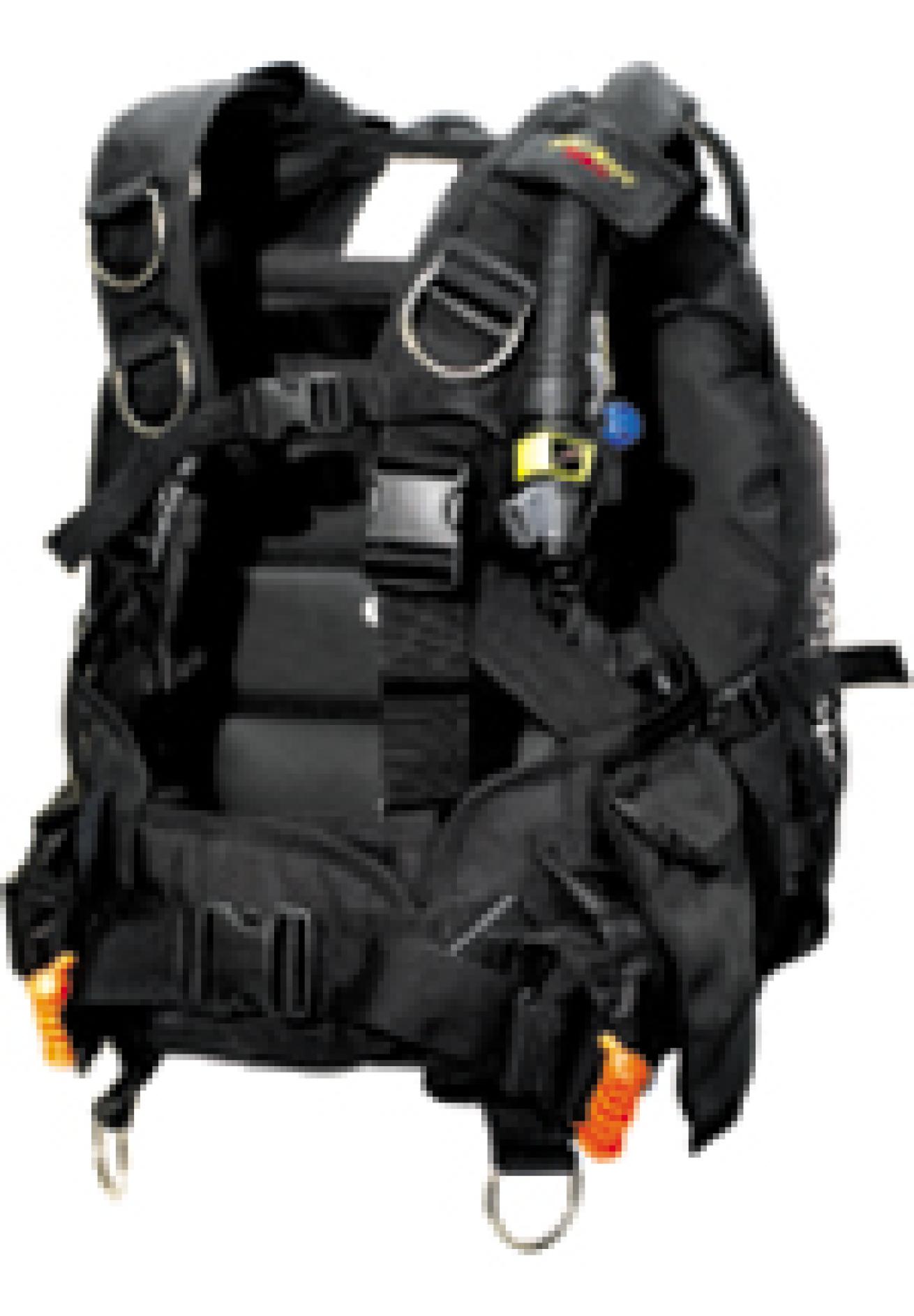
| | OCEAN MASTER Knight Pro| OCEAN MASTER Knight Pro
The back-buoyancy Knight Pro has a unique gel-filled pad to cushion the back and lumbar region, and the gel-padded under-shoulders are textured to reduce slippage. Combined with an efficient strap system, the BC provides a comfortable, supportive fit at depth. The BC could use a handle as well as a tank positioning strap.
The power inflator comes with an emergency horn as standard equipment. The horn is effective, but it tends to clutter up the inflator housing, making it too bulky for small hands and too busy for others, contributing to a fair score for valve operation. This, combined with an inefficient pull dump valve, also made it more difficult for test divers to maintain ascent control, resulting in an additional fair rating in that critical category.
However, test divers rated the one-step mechanical integrated weight system as good for weight loading and very good for weight ditching. The Knight Pro has five pounds of inherent buoyancy, the highest in this test group.
For More Info
AERIS
www.diveaeris.com
DACOR
www.divedacor.com
DEEPOUTDOORS
www.deepoutdoors.com
DIVERS UNLIMITED INTL.
www.dui-online.com
INTERNATIONAL DIVERS
www.internationaldivers.com
MARES
www.mares.com
OCEAN MASTER
www.oceanmaster.com
OCEANIC
www.oceanww.com
SEAQUEST
www.sea-quest.com
SHERWOOD SCUBA
www.sherwoodscuba.com
TUSA
www.tusa.com
Looking for Scubapro?
Scubapro has declined to provide its products for Scuba Lab tests, including this weight-integrated BCs review.
Weight Ditching Q & A
Q: Which is better: Velcro or mechanical systems?
A: When last we looked at weight-integrated BCs as a category, more than 70 percent of the BCs reviewed used Velcro security systems to prevent their weight pouches from ditching accidentally. This year, over 80 percent of BCs reviewed use mechanical security systems (although some of these use a bit of Velcro as back-up). This trend suggests that the majority of manufacturers have come to prefer the decisive click of a mechanical buckle when it comes to securing weight systems. However, don't discount Velcro systems: of the two BCs earning excellent scores for their integrated weight systems, the SeaQuest Fusion is mechanical, and the DeepOutdoors Matrix is, you guessed it, Velcro.
Q: Which is better: Hard or soft weights?
A: Although a number of BC owners' manuals recommend using soft weights in their weight pouches, it turns out soft weights can be a problem for some BC systems. Soft weights tend to work well in streamlined, contoured pouches that force soft weights to mold to--and then maintain--the shape of the pouch. But pouches that are too roomy, or that don't form fit against a diver's body, can allow soft weights to bunch up and settle in the bottom of the pouch like a lead blob, which can cause problems when it comes time to ditch. Granted, hard weights aren't as comfortable as soft weights, but they are often easier to load into pouches. They also allow the weight pouches to load easier into BC sleeves, and, because they tend to present a thinner profile in the pouch, they ditch more easily.
Q: Should I load weights before or after I put the BC on?
A: Loading before you put on the BC can be easier, but then you have to lift a lot more weight onto your back. Of course, depending on what BC you're wearing, loading weights after you put on your BC can range from easy-as-pie to downright difficult. Which way is best? It depends on who you ask. Either way, it doesn't hurt to get a little help from friends. If you load beforehand, your buddy can help you with the hefting. If you load afterward, your buddy can help you stuff pouches and make sure they're properly secured. Whether you load your BC before or after, fully deflate the bladder before inserting the pouches. And if you load while wearing the BC, pouches will often load into sleeves more easily if the cummerbund is unhooked.
Defining Flow Rates
This is how we now test for flow rates. In a heads-up ascent position, with the BC totally empty, at a depth of approximately 14 feet, the inflation valve is simultaneously activated for 20 seconds along with an applicable deflate valve (those located in the shoulder areas, or the highest valve on the BC while in a heads-up ascent position) to determine whether deflation can stay ahead of inflation. After 20 seconds, we note the results, and then immediately move to the next applicable valve and repeat the process.
BCs are scored for whether or not each exhaust valve can stay ahead of the power inflator. It's as simple as that. However, the number of exhaust valves that can stay ahead of the power inflator while in an ascent position is also noted. The way we see it, the more the better.
A Word About Buoyant Lift
Some weight-integrated BCs tested here are capable of being loaded with weight exceeding their total buoyant lift, especially in the smaller sizes. If you're a warm-water diver who wears minimal exposure protection and therefore needs little ballast weight, this is of little concern. However, if you dive with a thick wetsuit or dry suit with substantial ballast requirements, then you'd better make sure your BC has enough lift.
Past Scuba Lab tests have determined that a BC should provide enough buoyant lift to allow you to achieve neutral buoyancy at no more than 50 percent of its full inflation, under the most demanding conditions, i.e., maximum depth with maximum suit compression. This way you have a buoyancy reserve in case of emergencies.
For this reason, we also test manufacturer claims of buoyant lift. In this group of BCs, we once again found that the buoyant lift of some models varies considerably from what's stated in the owner's manual.

